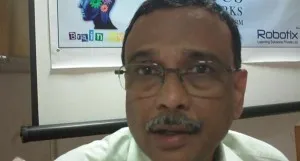Marry technology and learning – S. S. Nathan, CEO, BVM Global Bala Vidya Mandir

During a recent press briefing of Robotix Learning Solutions, the CEO of BVM Global Bala Vidya Mandir, S. S. Nathan, spoke to YourStory about technology in education.History
When we India got its Independence, we were thinking more in terms of how we are going to educate our masses. To educate the masses, we wanted our students to master a certain minimum. And now we are facing the situation where, though we have the advantage of numbers in our country, we do not have the quality. Quality, in the sense, we do not have the Nobel laureates. Going by simple mathematical calculation, if you have five Nobel laureates elsewhere in the world, we must have at least 10 times that number because of the population, but we do not have. The reason being we are still concentrating on the minimum standard that is expected for our country.
Technology
Time has come when we need to marry technology with what our education system already has. We are so thorough when it comes to waiting for someone to give us a command. Whenever there is a project, we expect somebody to come and tell us how to do the project. But in other learning situations, project is mentioned and the person who is working on the project prepares from the scratch to the fix. That is because young learners there are so empowered and they also have access to technology. Take, for example, diabetes, which is widely prevalent in India. But it is for somebody outside India to be leading in diabetes research, or finding even a simpler testing method. Why does this happen? We always wait for a teacher to teach us something. We never use the teacher to find out how to learn. Teacher always tells us what to learn. We never use the teacher to help us find out how to learn.
Learning
Now, from waiting for somebody to instruct, we need to move to learning by ourselves. Learning by ourselves is possible only when we start using the technology that is available. For example, we have Brain Gym, which is not only technology but also a way to maximise our capability, and enhance the right brain capabilities along with the left. In India, particularly, we don’t have any space for right dominance. Nobody ever thinks in terms of being highly imaginative. Nobody ever appreciates somebody who studies humanities. We think somebody is intelligent only when he is good in mathematics or engineering.
Imagination
Today, we need a mix of both right and left brain capabilities. You cannot have somebody as a scientist when he is very good at doing research, but does not have imagination. Only when you have imagination you can invent. So this is what happens elsewhere, but was all the time lagging in India. May be, we should blame the British; they never wanted us to be thinkers. All our children need to start thinking. When Srinivasa Ramanujan started doing his mathematical research, he would have depended on paper and pencil, but today we don’t have to. We have very good tools, so why not use those tools. What we aim is to make the children creative by thinking, maximising their brain learning. And, we also teach them robotics, where the children will learn to use the technology. Thus, we are able to marry technology and learning.







